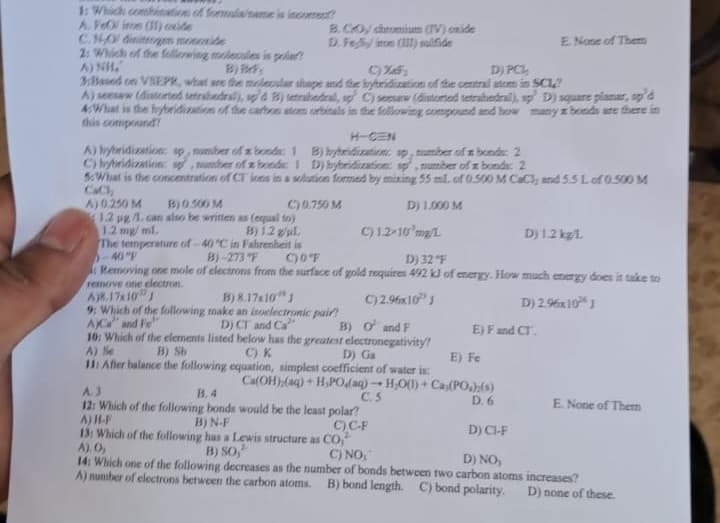11: After balance the following equation, simplest coefficient of water is: Ca(OH)(aq)+H,PO(aq)- H₂O(1) + Ca(PO)(s) C. 5 D.6 A.J B. 4 12: Which of the following bonds would be the least polar? QUE E) te E. None of Them
11: After balance the following equation, simplest coefficient of water is: Ca(OH)(aq)+H,PO(aq)- H₂O(1) + Ca(PO)(s) C. 5 D.6 A.J B. 4 12: Which of the following bonds would be the least polar? QUE E) te E. None of Them
Chemistry & Chemical Reactivity
10th Edition
ISBN:9781337399074
Author:John C. Kotz, Paul M. Treichel, John Townsend, David Treichel
Publisher:John C. Kotz, Paul M. Treichel, John Townsend, David Treichel
Chapter9: Bonding And Molecular Structure: Orbital Hybridization And Molecular Orbitals
Section: Chapter Questions
Problem 53IL: The sulfamate ion, H2NSO3, can be thought of as having been formed from the amide ion, NH2, and...
Related questions
Question
Q 11 please

Transcribed Image Text:1: Which combination of formula/name is incorrect?
A. Fel iron (1) oxide
C.NO/ dinitroge monoxide
2: Which of the following molecules is por
A thì
B.CO/ chromium(IV) onde
D. Fe,Sy iron (III) sulfide
B) Brf,
C%₂
D) PCL,
3:Based on VSEPR, what are the molecular shape and the hybridization of the central atom in SCI?
A) seesaw (distorted tetrahedral), spd 1) setraitedral, sp C) seesaw (distorted tetrahedral), sp D) square planar, sp'd
4:What is the hybridization of the carbon atoms orbitals in the following compound and how many bonds are there in
this compound?
A) hybridization: sp, number of x bonds: 1
C) hybridization: sp, number of x bonds: 1
B) hybridization: sp, number of x bonds: 2
D) bybridization: sp,number of a bonds: 2
5:What is the concentration of CT ions in a solution formed by mixing 55 ml. of 0.500 M CaC); and 5.5 L of 0.500 M
CaCh
D) 1.000 M
C) 0.750 M
A) 0.250 M
B) 0.500 M
1.2 pg 1. can also be written as (equal to)
1.2 mg/ ml.
B) 12 g/ul
C) 1.2-10 mg/L
The temperature of 40°C in Fahrenheit is
-40%
B)-273 "F
C)0°F
D) 32 °F
Removing one mole of electrons from the surface of gold requires 492 kJ of energy. How much energy does it take to
remove one electron.
D) 2.96x10¹" J
E. None of Them
A)8.17x10 J
B) 8.17x10" 1
C) 2.96x101
9: Which of the following make an isoelectronic pair!
ACa and Fe
D) CT and Ca
B)
O and F
10: Which of the elements listed below has the greatest electronegativity?
A) Se
B) Sb
C) K
D) Ga
11: After balance the following equation, simplest coefficient of water is:
E) F and CT.
E) Fe
Ca(OH),(aq)+H,PO,(aq)-H₂O(l) + Ca(PO.);(s)
D. 6
D) 1.2 kg/L.
A.3
B. 4
C. 5
12: Which of the following bonds would be the least polar?
A)H-F
B) N-F
C) C-F
D) CI-F
13: Which of the following has a Lewis structure as CO,
A). 0,
B) SO,¹
C) NO,
D) NO,
14: Which one of the following decreases as the number of bonds between two carbon atoms increases?
A) number of electrons between the carbon atoms. B) bond length. C) bond polarity.
D) none of these.
E. None of Them
Expert Solution
This question has been solved!
Explore an expertly crafted, step-by-step solution for a thorough understanding of key concepts.
Step by step
Solved in 3 steps with 3 images

Knowledge Booster
Learn more about
Need a deep-dive on the concept behind this application? Look no further. Learn more about this topic, chemistry and related others by exploring similar questions and additional content below.Recommended textbooks for you

Chemistry & Chemical Reactivity
Chemistry
ISBN:
9781337399074
Author:
John C. Kotz, Paul M. Treichel, John Townsend, David Treichel
Publisher:
Cengage Learning

Chemistry & Chemical Reactivity
Chemistry
ISBN:
9781133949640
Author:
John C. Kotz, Paul M. Treichel, John Townsend, David Treichel
Publisher:
Cengage Learning

Chemistry
Chemistry
ISBN:
9781305957404
Author:
Steven S. Zumdahl, Susan A. Zumdahl, Donald J. DeCoste
Publisher:
Cengage Learning

Chemistry & Chemical Reactivity
Chemistry
ISBN:
9781337399074
Author:
John C. Kotz, Paul M. Treichel, John Townsend, David Treichel
Publisher:
Cengage Learning

Chemistry & Chemical Reactivity
Chemistry
ISBN:
9781133949640
Author:
John C. Kotz, Paul M. Treichel, John Townsend, David Treichel
Publisher:
Cengage Learning

Chemistry
Chemistry
ISBN:
9781305957404
Author:
Steven S. Zumdahl, Susan A. Zumdahl, Donald J. DeCoste
Publisher:
Cengage Learning

Chemistry: An Atoms First Approach
Chemistry
ISBN:
9781305079243
Author:
Steven S. Zumdahl, Susan A. Zumdahl
Publisher:
Cengage Learning

General Chemistry - Standalone book (MindTap Cour…
Chemistry
ISBN:
9781305580343
Author:
Steven D. Gammon, Ebbing, Darrell Ebbing, Steven D., Darrell; Gammon, Darrell Ebbing; Steven D. Gammon, Darrell D.; Gammon, Ebbing; Steven D. Gammon; Darrell
Publisher:
Cengage Learning
